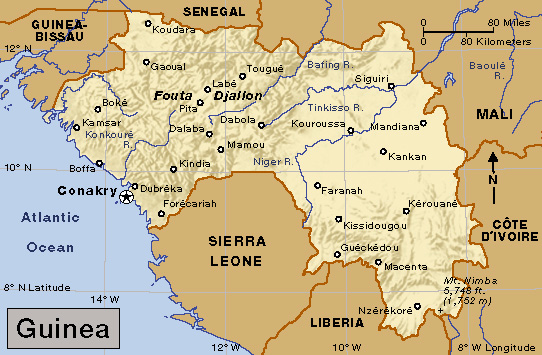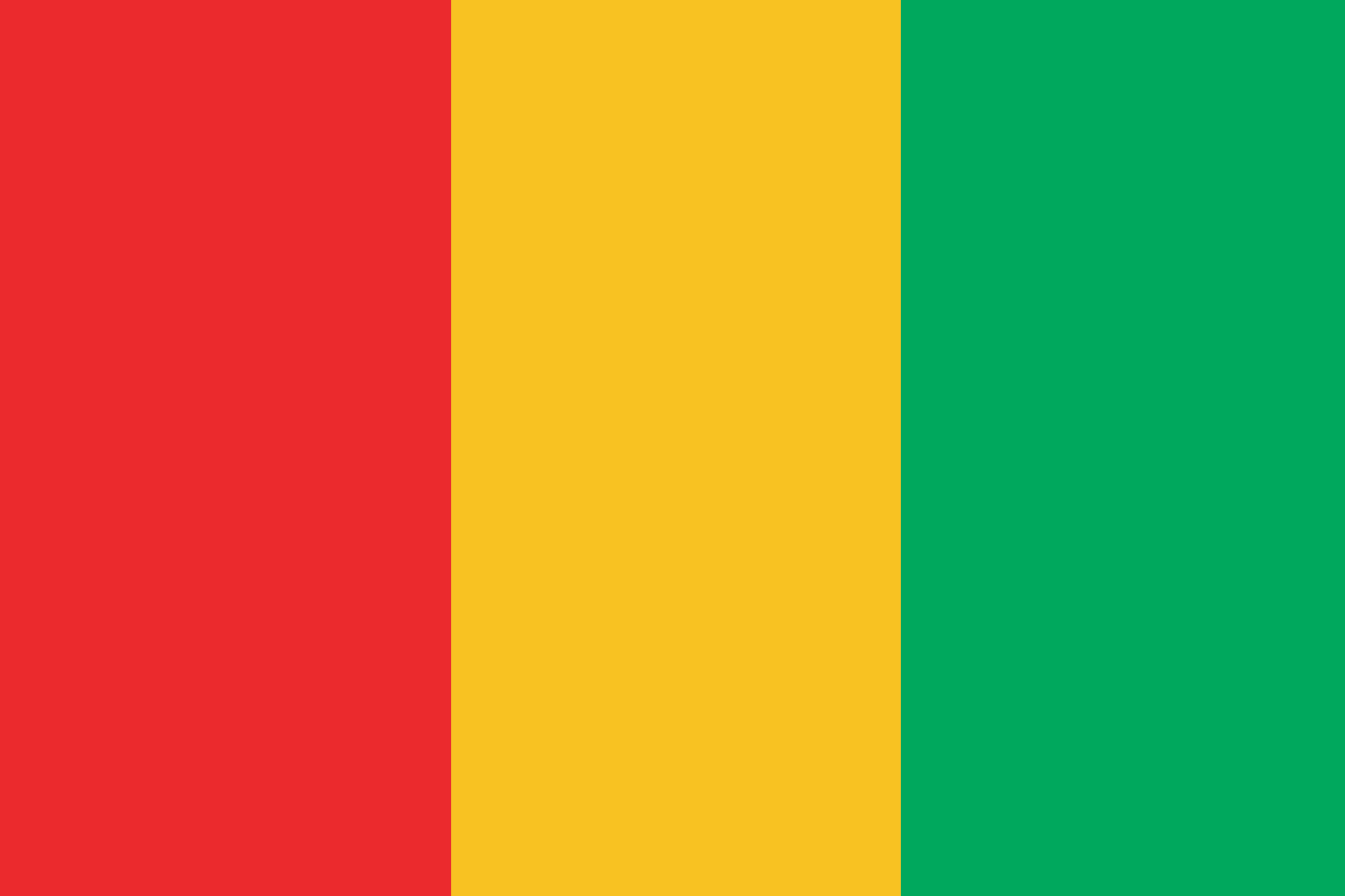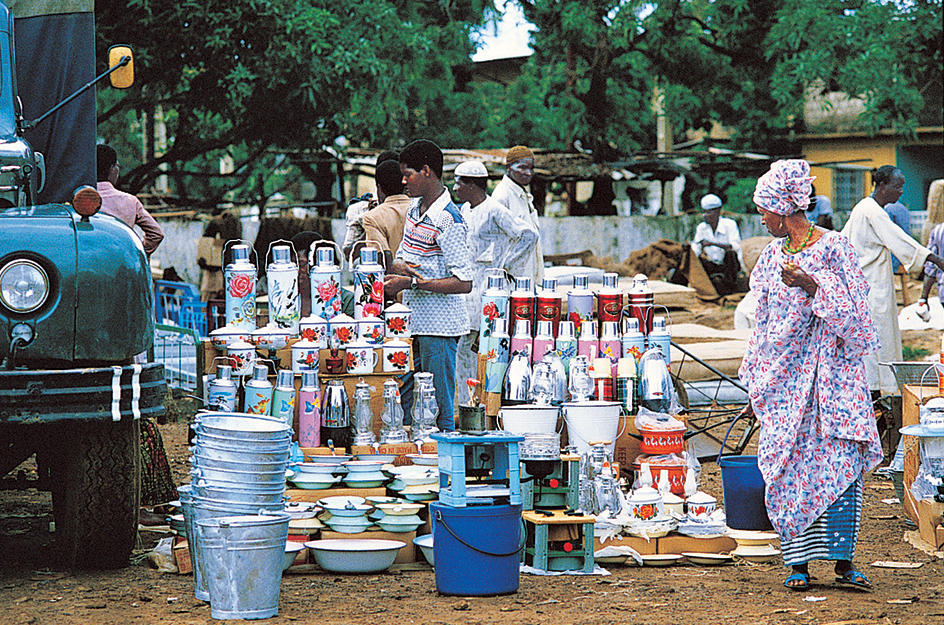Guinea << GIHN ee >> is a country on the west coast of Africa. It lies on the huge bulge of Africa that juts westward toward the Atlantic Ocean. Guinea is a land of coastal swamps, crusty plateaus, grassy plains, and forested hills. The country’s official name is République de Guinée (Republic of Guinea). Conakry is the capital and largest city.

Guinea has much potential for economic growth because of its abundant natural resources. Its economy is based on agriculture and mining. Guinea has large deposits of bauxite, a mineral from which aluminum is made. Guinea was a colony of France from the late 1800’s until 1958, when it gained independence.
Government.
Guinea’s most recent Constitution, adopted in 2010, was suspended following a military coup d’etat (sudden take-over of government) in 2021. Under the 2010 Constitution, the president of Guinea was the head of state. The people elected the president to a five-year term. The president appointed a prime minister, who served as head of government, and a cabinet, which helped administer the government. The Constitution established a one-house legislature called the People’s National Assembly. Assembly members were elected to five-year terms.

In the 2021 coup, Guinea’s military, led by Colonel Mamady Doumbouya, seized power. Doumbouya became interim president in October. In 2022, the government announced that there would be a three-year transition period before civilian rule would resume.
Guinea is divided into seven regions and the special zone of Conakry, the capital. Each of these eight units is headed by a governor appointed by the president. The regions are further divided into more than 30 government units called prefectures.
People.
The people of Guinea are called Guineans. About 75 percent of them belong to one of three main African ethnic groups. The largest group is the Fulani. Most Fulani live in a central plateau region called the Fouta Djallon. The Malinke, the second largest group, occupy much of northeastern Guinea, especially the towns of Kankan, Kouroussa, and Siguiri. The Susu, the third largest group, live along the coast. Smaller ethnic groups make up most of the rest of the population. Loading the player...
Guinea's national anthem
French is the official language of Guinea. But most people speak one of Guinea’s eight African languages. The majority of the people are Muslims. Most of the remaining Guineans either practice Christianity, especially Roman Catholicism, or follow traditional African religions.
Most Guineans live in rural areas. A majority of the rural people are farmers who raise crops to feed their families and for export. In the cities and towns, people work in business, manufacturing, or for service industries, including the government.
Most rural housing consists of round buildings made of sun-dried mud bricks, with a thatched roof. In the cities and towns, most people live in one-story rectangular houses made of mud bricks or wood. Few homes in Guinea have electric service or indoor plumbing. Conakry has a serious housing shortage.
Many Guineans, especially those living in cities and towns, wear clothing similar to that worn by North Americans and Europeans. However, most people still wear traditional clothes. For men, the traditional garment is a loose robe called a boubou. Women wear a blouse with a skirt made from a piece of colored cloth tied around the waist. 
Corn, millet, and rice are the main foods of Guineans. The grain is pounded into meal, cooked into porridge, and served with a sauce. A porridge made from a small-grained cereal called fonio is served with sour milk. Bananas are also an important food. Some meals include cassava and other vegetables and such fruits as mangoes, oranges, papayas, pineapples, or plantains. Beef, fish, lamb, and poultry are also popular foods. In addition, most Guineans enjoy homemade ginger drinks.
The government operates free public schools and requires all children between the ages of 7 and 19 to attend. However, many Guineans prefer to send their children to private Muslim schools. There is a shortage of teachers and classrooms. The country has universities in Conakry and Kankan. Most adult Guineans cannot read or write.
Guineans have a rich popular culture, which they express through music, oral folk tales, and drama. History, also an important part of Guinean culture, is recited by storytellers called griots. Guinean craftworkers make woven baskets, metal jewelry, and leather products.
Land and climate.
Guinea has four main land regions: (1) Lower Guinea, a swampy coastal strip; (2) Fouta Djallon, or Middle Guinea, a central plateau of hard, crusty soil; (3) Upper Guinea, a northern savanna (grassland with scattered trees); and (4) the Forest Region, an area of forests and hills in the southeast. This region includes the country’s highest point, Mount Nimba, which rises to 5,748 feet (1,752 meters) above sea level. Guinea has many rivers, including the sources of the Niger, the Senegal, and the Gambie (Gambia) rivers.
Clumps of mangrove trees grow along the mouths of Guinea’s rivers. The wildlife in Guinea includes such animals as antelope, buffaloes, crocodiles, elephants, hippopotamuses, leopards, lions, monkeys, and snakes.
Guinea has a tropical climate. Average temperatures in Lower Guinea along the coast range from 73 to 84 °F (23 to 29 °C). Lower Guinea receives about 110 inches (279 centimeters) of rain each year. The Fouta Djallon region is cooler than the coast, and it receives from 60 to 100 inches (152 to 254 centimeters) of rain a year. Upper Guinea is drier than the coast, with a rainfall of about 60 inches (152 centimeters) a year. The Forest Region is humid and cool, and receives from about 75 to 100 inches (190 to 254 centimeters) of rain each year.
Economy.
Guinea is a poor country with a high poverty rate. Although underdeveloped, Guinea has many valuable natural resources. The country has the world’s largest reserve of bauxite. Guinea is one of the world’s leading bauxite producers. Other important mineral deposits include diamonds, gold, iron ore, and uranium.
About 75 percent of Guinea’s people work in agriculture. They grow bananas, cassava, coffee, corn, fonio, peanuts, pineapples, plantains, rice, sweet potatoes, and other crops. Farmers in the plains and highlands raise beef and dairy cattle, goats, and sheep. The country’s fishing and forestry industries are underdeveloped. Manufacturing plays a small role in Guinea’s economy. Factories in Guinea manufacture food products and alumina (a processed form of bauxite).
Alumina, bauxite, diamonds, and gold account for most of Guinea’s export income. Guinea also exports coffee and other agricultural products and fish. Leading imports include machinery, motor vehicles, petroleum products, pharmaceuticals (medicinal drugs), and rice and other food products. Guinea’s main trade partners include Belgium, China, France, Spain, the United Arab Emirates, and the United States.
Inadequate transportation systems hamper economic development in Guinea. The country’s roads are in poor condition, and less than half of them are paved. Conakry has an international airport. Conakry and Kamsar serve as international shipping ports.
The government of Guinea controls the country’s main radio and television stations. Privately owned radio stations also operate throughout the country. Many people own radios, but few have television sets. The government controls Guinea’s only daily newspaper.
History.
Stone tools found in several places throughout what is now Guinea indicate that people have lived in the area since prehistoric times. People from the Sahara region had probably migrated to Guinea by about 2000 B.C. Early inhabitants hunted and gathered wild fruit. By about 1000 B.C., people had begun to raise livestock and grow crops, and agricultural societies largely replaced hunting communities.
Parts of Guinea fell under the control or influence of several empires from the A.D. 1000’s to 1500’s. The gold-producing region of Upper Guinea came under the influence of the Ghana Empire in the 1000’s. The Mali Empire, founded by the Malinke people, was the most powerful state in Guinea from the 1200’s to the 1500’s. Fulani from the north moved to Guinea from the 1300’s to about 1700. Muslim Fulani and Malinke fought a jihad (holy war) against non-Muslim Fulani and Malinke in the early 1700’s, and they then gained control of the Fouta Djallon.
Portuguese explorers were the first Europeans to reach Guinea, beginning in the mid-1400’s. By the 1600’s, traders from other European nations also had entered West Africa. France began to control parts of Guinea in the mid-1800’s. The French gained territory through treaties and through conquest. In 1891, Guinea became a French colony called French Guinea. Samory Toure, a powerful Malinke leader, resisted French rule, but was defeated and captured in 1898.
After World War II ended in 1945, political parties and labor unions became active in Guinea. The Democratic Party of Guinea (Parti Democratique de Guinee, or PDG) was formed in 1947. Sekou Toure became its head in 1952. The PDG won control of the legislature in 1957. On Sept. 28, 1958, the people of Guinea voted for complete independence from France. Guinea officially became independent on October 2, with Toure as its first president. Guinea’s first constitution took effect on November 12. In December, a law made the PDG Guinea’s only political party.
The government under Toure and the PDG took nearly complete control of Guinea’s economy in an effort to create a socialist state. The government also hoped to encourage unity among the peoples of the new nation and strengthen Guinea’s ties with other African countries and socialist nations. But there were many problems. Guinea failed to develop its plentiful natural resources, and most of the country’s people remained poor. Throughout the 1960’s and early 1970’s, Toure’s government crushed all opposition to his policies and imprisoned many citizens without cause.
Toure died on March 26, 1984. In early April, military leaders took control of the government. They suspended the constitution and abolished the PDG. Colonel Lansana Conté, the leader of the ruling military committee, became president. His government abandoned Toure’s socialist economic policies and adopted free enterprise policies. It also strengthened economic ties with France and other countries. In 1990, Guinean voters approved a new constitution that provided for a transition to civilian rule and multiparty democracy. In 1993, Guinean voters elected Conté as president in multiparty elections. Conté’s party, the Party of Unity and Progress (PUP), won the majority of seats in elections for the civilian legislature in 1995 and 2002. The voters reelected Conté as president in 1998 and 2003.
During the 1900’s and early 2000’s, hundreds of thousands of people fled to Guinea to escape civil wars in Liberia and Sierra Leone. In 2000 and 2001, Guinean rebels, as well as invaders from Sierra Leone’s rebel Revolutionary United Front and from various groups in Liberia, took part in major fighting against Guinean government forces.
In January 2007, labor unions began a strike to protest against Conté. The strike turned into violent demonstrations. In February, Conté declared a state of emergency. As part of an agreement to end the strike, Conté stepped down as head of government and appointed a prime minister.
On Dec. 22, 2008, Conté died. A group of military leaders then seized power. They dissolved Guinea’s government and installed a temporary government. Most countries condemned the coup. The military government approved a revised constitution in 2010. A presidential election held that year was widely condemned as fraudulent. In a runoff election, opposition leader Alpha Condé was elected president. Voters elected a new legislature in 2013. Condé was reelected in 2015.
Voters had hoped that Condé could unify the country’s various ethnic groups, and that Guinea’s natural resources would produce better economic conditions for all. By the end of the 2010’s, however, many people had become disappointed in his leadership. Although economic conditions in the country had improved for some, the wealth did not trickle down to most of the people. Also, while a majority of Guineans belonged to the Fulian ethnic group, the minority Malinke group, to which Condé belonged, held power.
In March 2020, Condé called for a constitutional amendment that would allow him to run for a third term as president. Opposition groups boycotted the referendum, but the amendment passed. Condé was reelected president in October in an election the opposition claimed was marked by widespread fraud. In September 2021, the military, led by Colonel Mamady Doumbouya, seized power. They removed Condé from office, suspended the Constitution, and set up a transitional government of national unity. Doumbouya became interim president in October. In May 2022, the government announced that there would be a three-year transition period before civilian rule would resume.
